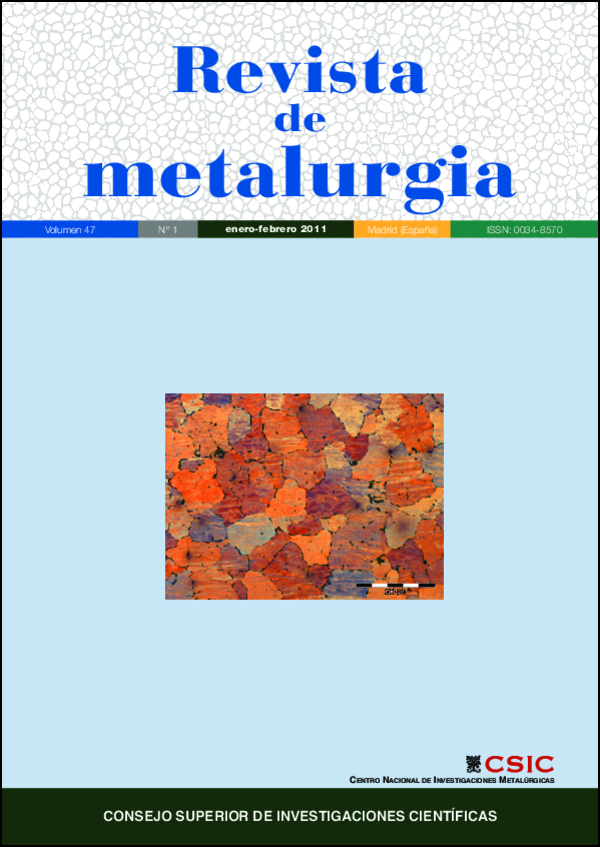Analisys of the influence of the multipass welding, welding pre heat and welding post heat treatments on the behaviour of GMAW joints of HARDOX 400 microalloyed steel
DOI:
https://doi.org/10.3989/revmetalmadrid.1007Keywords:
Weldability, Hardox 400, Preheating, Welding postheating, Microalloyed steelAbstract
The microalloyed steels may be supplied in a hardened state. In these cases, the weldability can be improved by pre-heat and/or post-heat welding treatments. In this paper, the effect of those treatments and the influence of multipass welding on GMAW joints behavior are analyzed for a Hardox 400 microalloyed steel. The microstructure evaluation of the different heat affected zones of the steel has been made and the mechanical properties of those zones are obtained for different conditions as it has been mentioned. The obtained results indicate that preheating the steel leads to a beneficial action that consists on the distance increasing from the bead to the zone in which the hardness is lowest. The postheat treatment strengthens that zone and improves the joint plasticity. This benefit is higher if the joint has been made with preheating. Multipass welding has not been found to have any advantage if it is compared to a single welding pass.
Downloads
References
[1] X-H. Xue, Y-Y. Shan, L. Zheng y S-N. Lou, Mater. Sci. Eng. A 438-440 (2006) 285-287. doi:10.1016/j.msea.2006.02.064
[2] M. Zrilic, V. Grabulov, Z. Burzic, M. Arsic y S. Sedmak, Int. J. Pres. Ves. Pip. 84 (2007) 139-150. doi:10.1016/j.ijpvp.2006.09.021
[3] R. Lagneborg, Mater. Des. 12 (1991) 3-14. doi:10.1016/0261-3069(91)90086-J
[4] P. Kulu, R. Veinthal, M. Saarna and R. Tarbe. Wear 263 (2007) 463-471. doi:10.1016/j.wear.2006.11.033
[5] H.McI.Clark y R.J. Llewellyn.Wear 250 (2001) 32-44. doi:10.1016/S0043-1648(01)00628-7
[6] SSAB, Ficha Técnica Hardox 400. 2007-04- 02. www.SSAB.com.
[7] S. Ravi, V. Balasubramanian, S. Babu y S.Nemat Nasser. Eng. Fail. Anal. 11 (2004) 619-634. doi:10.1016/j.engfailanal.2003.06.006
[8] S. Ravi,V. Balasubramanian, S. Babu y S.Nemat Nasser.Mater. Des. 25 (2004) 125-135. doi:10.1016/j.matdes.2003.09.016
[9] S. Ravi, V. Balasubramanian y S. Nemat Nasser. Int. J. Fatig. 27 (2005) 547-553. doi:10.1016/j.ijfatigue.2004.09.006
[10] Welding Handbook, Welding Technology. American Welding Society, Eight Edition, Vol. 11.991, pp. 33-34.
[11] P.R. Sreenivasan, S.K. Ray, K.G. Samuel y S.L.Manna, Eng. Fract.Mech. 42 (1992) 1.047- 1.049.
[12] T. Otarola, B. Bonnefois, M. Anglada, L. Coudreuse, y A. Mateo, Anales de Mecánica de la Fractura, Vol. II, Albarracín (Teruel, España), 2006, pp. 459-464.
[13] IIW / IIS, Welding in the World, Guidelines for the classification of ferritic steel weld metal. Vol. 24 (1986) N. 7/8, pp. 144-149.
[14] A.G. Olabi y M.S.J. Hashmi. J. Mat. Process. Tech. 55 (1995) 117-122. doi:10.1016/0924-0136(95)01794-1
[15] D. Tawfik, P.J. Mutton y W.K. Chiu. J. Mat. Process. Tech. 196 (2008) 279-291. doi:10.1016/j.jmatprotec.2007.05.055
[16] A.M. Paradowska, J.W.H. Price, R. Ibrahim, T.R. Finlayson, M.I. Ripley y R. Blevins. J. Neutron Res. 1.477-2.655, Vol. 15, Issue 3 (2007) 231-241.
[17] Z. Feng, Processes and Mechanisms of welding residual stress and distortion, Ed. Woohdhead Publishing Limited, England, (2005) p. 8.
[18] P. Nevasmaa, Ph. Doctoral Thesis, Department of Mechanical Engineering, Oulu University, (2003).
Downloads
Published
How to Cite
Issue
Section
License
Copyright (c) 2011 Consejo Superior de Investigaciones Científicas (CSIC)

This work is licensed under a Creative Commons Attribution 4.0 International License.
© CSIC. Manuscripts published in both the printed and online versions of this Journal are the property of Consejo Superior de Investigaciones Científicas, and quoting this source is a requirement for any partial or full reproduction.
All contents of this electronic edition, except where otherwise noted, are distributed under a “Creative Commons Attribution 4.0 International” (CC BY 4.0) License. You may read the basic information and the legal text of the license. The indication of the CC BY 4.0 License must be expressly stated in this way when necessary.
Self-archiving in repositories, personal webpages or similar, of any version other than the published by the Editor, is not allowed.
















